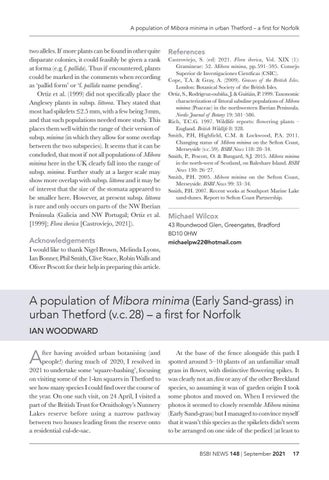A population of Mibora minima in urban Thetford – a first for Norfolk
two alleles. If more plants can be found in other quite disparate colonies, it could feasibly be given a rank at forma (e.g. f. pallida). Thus if encountered, plants could be marked in the comments when recording as ‘pallid form’ or ‘f. pallida name pending’. Ortiz et al. (1999) did not specifically place the Anglesey plants in subsp. littorea. They stated that most had spikelets ≤2.5 mm, with a few being 3 mm, and that such populations needed more study. This places them well within the range of their version of subsp. minima (in which they allow for some overlap between the two subspecies). It seems that it can be concluded, that most if not all populations of Mibora minima here in the UK clearly fall into the range of subsp. minima. Further study at a larger scale may show more overlap with subsp. littorea and it may be of interest that the size of the stomata appeared to be smaller here. However, at present subsp. littorea is rare and only occurs on parts of the NW Iberian Peninsula (Galicia and NW Portugal; Ortiz et al. [1999]; Flora iberica [Castroviejo, 2021]).
Acknowledgements
I would like to thank Nigel Brown, Melinda Lyons, Ian Bonner, Phil Smith, Clive Stace, Robin Walls and Oliver Pescott for their help in preparing this article.
References
Castroviejo, S. (ed) 2021. Flora iberica, Vol. XIX (1): Gramineae: 52. Mibora minima, pp. 591–595. Consejo Superior de Investigaciones Cientficas (CSIC). Cope, T.A. & Gray, A. (2009). Grasses of the British Isles. London: Botanical Society of the British Isles. Ortiz, S., Rodrígeuz-oubiña, J. & Guitián, P. 1999. Taxonomic characterization of littoral sabuline populations of Mibora minima (Poaceae) in the northwestern Iberian Peninsula. Nordic Journal of Botany 19: 581–586. Rich, T.C.G. 1997. Wildlife reports: flowering plants – England. British Wildlife 8: 328. Smith, P.H, Highfield, C.M. & Lockwood, P.A. 2011. Changing status of Mibora minima on the Sefton Coast, Merseyside (v.c. 59). BSBI News 118: 28–34. Smith, P., Pescott, O. & Bungard, S.J. 2015. Mibora minima in the north-west of Scotland, on Baleshare Island. BSBI News 130: 26–27. Smith, P.H. 2005. Mibora minima on the Sefton Coast, Merseyside. BSBI News 99: 33–34. Smith, P.H. 2007. Recent works at Southport Marine Lake sand-dunes. Report to Sefton Coast Partnership.
Michael Wilcox
43 Roundwood Glen, Greengates, Bradford BD10 0HW michaelpw22@hotmail.com
A population of Mibora minima (Early Sand-grass) in urban Thetford (v.c. 28) – a first for Norfolk IAN WOODWARD
A
fter having avoided urban botanising (and people!) during much of 2020, I resolved in 2021 to undertake some ‘square-bashing’, focusing on visiting some of the 1-km squares in Thetford to see how many species I could find over the course of the year. On one such visit, on 24 April, I visited a part of the British Trust for Ornithology’s Nunnery Lakes reserve before using a narrow pathway between two houses leading from the reserve onto a residential cul-de-sac.
At the base of the fence alongside this path I spotted around 5–10 plants of an unfamiliar small grass in flower, with distinctive flowering spikes. It was clearly not an Aira or any of the other Breckland species, so assuming it was of garden origin I took some photos and moved on. When I reviewed the photos it seemed to closely resemble Mibora minima (Early Sand-grass) but I managed to convince myself that it wasn’t this species as the spikelets didn’t seem to be arranged on one side of the pedicel (at least to BSBI NEWS 148 | September 2021
17

















